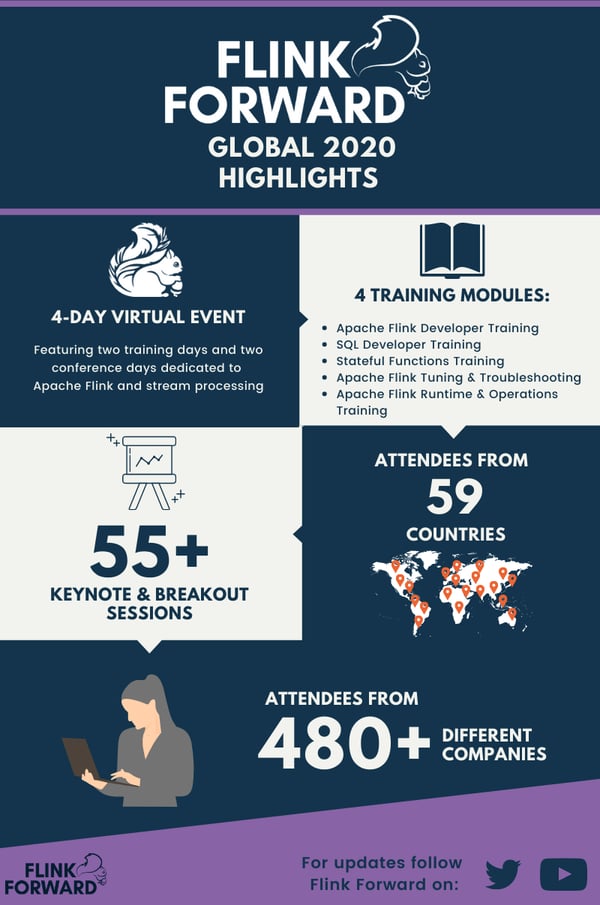Flink Forward Global 2020 Recap
On October 19-22, 2020 we virtually welcomed more than 1,500 members of the Apache Flink® community at Flink Forward Global 2020. The second virtual Flink Forward featured several exciting keynote and breakout sessions and two full training days with four different tracks to get participants up-to-speed with the latest features and developments around Flink. If you did not have time to attend, you can now access all the session recordings on the Flink Forward YouTube channel and send us your feedback by signing up here.
In the following sections, we will highlight some of our observations from the conference, general impressions, and overall trends from this event.

Keynote Sessions
Both conference days opened up with exciting keynotes highlighting the current state of Flink and our community, future direction, and showcasing the diverse set of use cases and applications that Flink powers across a wide range of industries. Ververica’s Stephan Ewen discussed how active the Flink community remains and what comes after the unification of batch and streaming. Konstantin Knauf explained how Flink SQL has emerged as a de-facto standard for distributed data processing and introduced Ververica Platform 2.3 that has evolved into an end-to-end environment for the execution and deployment of Flink SQL queries. Peter Chalif from Citi Group explained how Apache Flink and stream processing infrastructure has become a fundamental building block for designing modern trading systems in financial institutions. Alibaba’s Xiaowei Jiang presented Hologres, a cloud-native Hybrid Serving/Analytical Processing (HSAP) database, a next-generation data warehouse for unified data storage and data services. Two additional inspiring keynotes from Ricky Saltzer and Renu Tewari further explained how Flink is powering real-time metrics for extreme scale at Fortnite and how LinkedIn’s journey with stream processing has evolved over the years.
Hot topics and key highlights
While taking a closer look at the talks, online discussions, and questions at the virtual event, it became clear that the following topics were major trends in stream processing and Apache Flink this year:
- Flink SQL as a unified standard for batch and streaming workloads of all kinds.There were both live coding sessions with Flink SQL as well as breakouts focusing on Flink SQL and how it can be utilized for either unified batch and streaming workloads with its integration for Apache Hive or for Change Data Capture (CDC) and real time processing.
- Flink for Machine Learning including use cases such as feature generation, model training and model serving.Multiple breakout sessions discussed how Flink powers Machine Learning workloads, from low-latency feature generation to developing an entire Machine Learning (ML) infrastructure with Apache Flink, or performing dynamic model serving at scale, while others introduced TensorFlow on Flink for deep learning workloads.
- Flink powers unified streaming platforms at various companies.Companies like Intuit, Pinterest, and Uber showcased how they build, maintain and operate Flink-based, unified streaming platforms to democratize data stream processing in their wider technology organization.
We were once again excited to witness how global the Apache Flink® community remains, after welcoming participants from more than 59 countries and 480 different companies. We are truly thankful for everyone who participated at the virtual event, from our speakers, showcasing how they are using Flink, attendees keeping interactions and discussions alive, and our sponsors who continue to support the Flink community with different ways and contributions. To get a full picture of the events’ contents, make sure to subscribe to our Forward YouTube channel or sign up to the Flink Forward newsletter to stay up to date with announcements about upcoming events, call for presentations, deadlines, and more exciting news about Flink Forward.

You may also like

Meet the Flink Forward Program Committee: A Q&A with Lorenzo Affetti
Meet Lorenzo Affetti, a Program Committee member for Flink Forward 2025, ...

Outrun Fraudsters with Agentic AI and Ververica
Enhance fraud detection with agentic AI and Ververica's real-time stream ...

KartShoppe: Real-Time Feature Engineering With Ververica
Discover how KartShoppe leverages Ververica’s real-time feature engineeri...

Maximize Efficiency: How Ververica's BYOC Deployment Optimizes CAPEX and OPEX
Learn how Ververica's BYOC deployment leverages CAPEX and OPEX to optimiz...















